1. Introduction
April 1879. Ferdinand Cheval, a 43-year-old rural postman, stumbles upon a stone so strange during his rounds that it awakens a dream. A true autodidact, he devoted 33 years of his life to building a dream palace in his vegetable garden, inspired by nature, postcards and the first illustrated magazines he distributed.
Every day he travelled over 30 kilometres to collect stones in the countryside with the help of his trusty wheelbarrow. A loner, misunderstood, he inscribed on his monument “the work of one man”. His dream palace was completed in 1912.
“My foot had caught a stone which almost made me fall: I wanted to know what it was. It was a stumbling block of such a strange shape that I put it in my pocket to admire it at my leisure.
The next day, I went back to the same place; I found even more beautiful ones. I said to myself: if nature wants to make sculpture, I will make masonry and architecture.”
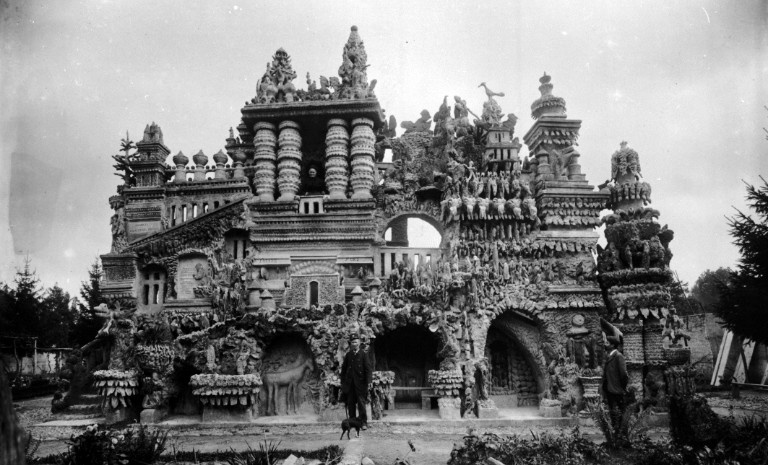
In the heart of a luxuriant garden, he imagines an uninhabitable palace, populated by an incredible bestiary – octopus, deer, caiman, elephant, pelican, bear, birds… But also giants, fairies, mythological characters or even waterfalls, architectures from all continents. An architectural work that is as unclassifiable as it is universal.
Unique in the world, the Ideal Palace has inspired artists for over a century. Independent of any artistic movement, built without any architectural rules, the Ideal Palace was admired by the surrealists. In 1969, it was classified as a historical monument by André Malraux, then Minister of Culture, in the context of naive art.
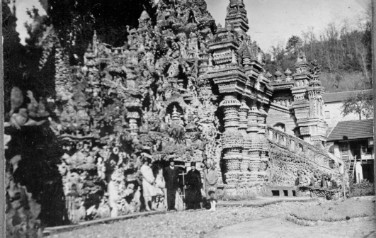
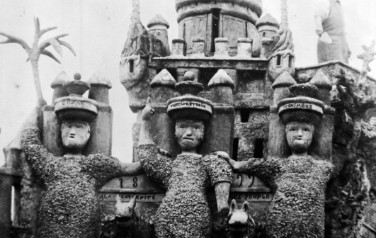
2. The man
His time, the 19th century, was a time of great misery, when famine and disease took their toll. It was also a time of great revolutions in many fields: the end of the monarchy and the beginnings of the republic, progress in science and medicine, Freud’s discoveries about the unconscious and dreams, the industrial revolution, the arrival of the railway, the colonisation by France of Africa and Asia, the birth of public and secular schools, the presentation of the first universal exhibitions…
This was a rich period, described and illustrated in the gazettes that were widely read at the time, such as the Magasin Pittoresque or La revue illustrée (gazettes distributed by all rural postmen), to which was added the birth of photography and the appearance of the first postcards. These information media opened up the rural world to the city, other regions and even the planet. They were to feed the imagination of the Postman Cheval in an extraordinary way.
Chronologie
Childhood
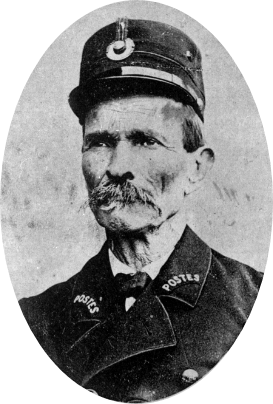
Joseph Ferdinand Cheval was born on April 19th at 5am in Charmes sur l’Herbasse, a small village near Hauterives in 1836.
He belonged to a rather poor farming family and started working with his father at an early age. His school education was very limited. He entered school at the age of 6 and left at 12.
He became a baker’s apprentice and went away from his family for a few years to find work, before returning to his village, where he became a rural postman.
When he was just 11 years old, his mother, Rose Françoise Silbert, died. His father, Jean François Cheval, died a few years later, in 1854. While he was still a minor, Joseph Ferdinand Cheval was entrusted to his maternal uncle, Joseph Burel.
Joseph Ferdinand Cheval was 20 years old. He was an apprentice baker in Valence. When he was old enough to do his military service, he was exempted, perhaps because of his small size.
He married Rosalie Revol who was just 17 years old. It was a period when he left Hauterives to find work. During 6 years, his administrative trace was somewhat lost and his wife confirmed that she did not know where he was. He was declared a farmer in Hauterives, a baker in the Rhône… He returned to Hauterives in 1863.
Rosalie gave birth to their first son, Victorin Joseph Fernand. A year later the child died. Their second son, Ferdinand Cyrille, was born two years later.
At the age of 31, Joseph Ferdinand Cheval took an oath to be a letter carrier at the Post Office. He was transferred to the Romans office, then to Bourg de Péage.
His wife Rosalie died. At the age of 37, Joseph Ferdinand Cheval entrusted his son Cyrille to his godfather and godmother. 3 years after this event, he was transferred to Saint Rambert d’Albon.
He got his final transfer as a rural letter carrier to the Hauterives office for the Tersanne round. Every day he walked about 30 kilometers. A few months later, he met Claire-Philomène-Richaud, whom he married for the second time.
On April 19, Joseph Ferdinand Cheval, then 43 years old, stumbled on “his stumbling block” near Tersanne, during his tour. It was this stumbling block that triggered the construction of his ideal palace for 33 years without respite. It is this same year, on October 11, that his daughter, Alice-Marie-Philomène, was born.
Alice died at the age of 15. A tragedy for Joseph Ferdinand Cheval who inscribed on the family tombstone “Alice bitterly regretted”.
Joseph Ferdinand Cheval was retired at the age of 60. With the help of a mason, he built the “Villa Alicius” where he settled with his wife.
First article published in the national press, in the magazine “La Vie Illustrée”.
Ferdinand Cheval took on a maid, Julia Micoud, who was in charge of guiding visitors around the Ideal Palace.
Completion of the Ideal Palace. Two years later, Joseph Ferdinand Cheval took up his faithful wheelbarrow to build his tomb in the village cemetery of Hauterives, “The Tomb of Silence and Endless Rest”, completed in 1922. His son Cyril died that same year. His wife died 2 years later in 1914.
Ferdinand Cheval died on August 19. Two days before, he certified the final version of his biography as “sincere and true” (4th version dated 1911). The Ideal Palace was managed by his two granddaughters (daughters of Cyril, his son).
The Palais Idéal was classified as an historical monument by André Malraux, who considered it the only example of naive art in architecture.
First restoration project of the Palais Idéal and its gardens.
Alice, one of J.F. Cheval’s granddaughters, who had no descendants, decided to bequeath her share of the Palais to the commune of Hauterives. 10 years later, her second granddaughter sold her share to the local authority. Since 1994, the Ideal Palace has belonged to the town of Hauterives.
The Palace welcomed 305,000 visitors from all over the world.
3. The building
The East façade is where it all begins. In the middle, a fountain “The Source of Life” surrounded by a lion and a dog was the first construction made by the Facteur Cheval. He added fountains, grottoes and temples in a frenzy, accumulating stones, shells and lime mortar. On the right, he added an Egyptian tomb with the intention of being buried there with his wife, which was refused.
On the left, the Hindu temple with a niche where his famous and faithful wheelbarrow is hidden. The three giants complete the façade. It is written 1899, Ferdinand Cheval spent 20 years working on this east side.
It was on the South side that Ferdinand Cheval decided to place his Antediluvian Museum, a cave in which the Facteur Cheval collected stones waiting to be used in the work under construction.
The West facade is an invitation to travel. Thanks to the illustrations of his time, Ferdinand Cheval reproduced in niches a Swiss Chalet, a Hindu temple, the White House, the Square House of Algiers, a Castle in the Middle Ages. A Mosque opens onto the inside of the Ideal Palace, the Gallery.
On the classical style columns, he wrote the letters: C H E V A L, as a signature of his work.
The Gallery, a long interior corridor, is populated by an extraordinary bestiary: dromedary, bear, elephant, cat, wolf, flamingo are modelled in bas-reliefs.
The poem “Ton idéal, ton Palais” by Emile Roux Parassac, which inspired the name of the monument to Postman Cheval, is inscribed at the entrance to this gallery.
Three staircases lead to the Terrace, where Ferdinand Cheval placed his “stumbling block”, the first stone on which he tripped and which inspired him to create his ideal Palace. At the top of the Palace, between prickly pear trees and aloes, stands the Barbary Tower. A water reservoir used to supply the Palace and its fountain, the “Source of Life”, with water. Only a few visitors at the time of Ferdinand Cheval were able to watch this spectacle.
The water damaged the building too much and the system had to be stopped.
The North façade is the result of 33 years of work. The octopus sculpted at the western corner is the final point of the work. On the opposite side of the building, he wrote: “10,000 days, 93,000 hours, 33 years of hardship, more stubborn than myself trying to start work”.
With its rich ornamentation, populated with animals and other mythological beasts under the gaze of Adam and Eve, the North façade is an echo of the last work of the Facteur Cheval, his tomb of silence and endless rest, in the cemetery of Hauterives.
Today, he rests with all his family in this famous tomb that took him 8 years to build after the 33 years of work required for the Ideal Palace.
“AFTER FINISHING MY DREAM PALACE AT THE AGE OF SEVENTY-SEVEN AND THIRTY-THREE YEARS OF HARD WORK I WAS STILL BRAVE ENOUGH TO GO AND MAKE MY GRAVE IN THE PARISH CEMETERY.
THERE AGAIN I WORKED FOR EIGHT YEARS OF HARD LABOUR. I WAS LUCKY ENOUGH TO HAVE THE HEALTH TO COMPLETE THIS TOMB, CALLED “THE TOMB OF SILENCE AND ENDLESS REST”, AT THE AGE OF 86.
THIS TOMB IS LOCATED A SHORT DISTANCE FROM THE VILLAGE OF HAUTERIVES. HIS KIND OF WORK MAKES IT VERY ORIGINAL, ALMOST UNIQUE IN THE WORLD, IN FACT IT IS THE ORIGINALITY THAT MAKES IT BEAUTIFUL.
MANY VISITORS ALSO VISIT IT AFTER SEEING MY “PALACE OF DREAMS” AND RETURN HOME AMAZED, TELLING THEIR FRIENDS THAT THIS IS NOT A FAIRY TALE, THAT IT IS THE REAL THING. YOU HAVE TO SEE IT TO BELIEVE IT. IT IS ALSO FOR ETERNITY THAT I WANTED TO COME AND REST IN THE FIELD OF EQUALITY. “
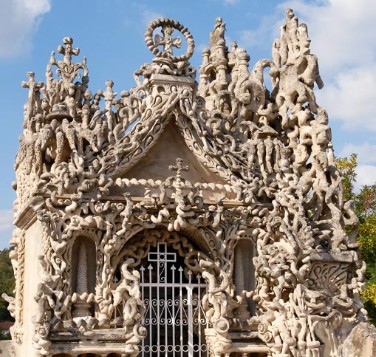
4. The recognition
Alongside institutional art and its networks, a few self-taught artists who are complete strangers to this world have distinguished themselves with original productions. Their works, on the fringes of artistic trends, refer only to the imagination of their authors and their need to create. All these creators were often not recognised by institutions until long after their death. They have become references today.
Recognised as a work of art in its own right by various artistic movements, the Ideal Palace of the Postman Cheval is often described as an unclassifiable work. A work that was classified as a historical monument in 1969 by André Malraux.
RECOGNITION BY THE SURREALISTS
Around 1920, André Breton considered it to be a precursor of surrealist architecture. Breton visited the Palais idéal on several occasions, accompanied by other artists, notably the photographers Denise Bellon and Léonora Carington (Max Ernst‘s companion). Both of them took photographs of the Ideal Palace which were exhibited at the Moma in New York in 1936.
In 1932, André Breton paid tribute to the Facteur Cheval in a poem entitled “Le Revolver à cheveux blancs”.
Similarly, the artist Max Ernst created a tribute to Ferdinand Cheval which is on display at the Guggenheim Foundation in Venice.
A REFERENCE FOR NAIVE ART ACCORDING TO ANDRÉ MALRAUX
Considering the Palace to be the only example of naive architecture, André Malraux decided to have it classified in 1969. He was right in his decision, as Breton, Picasso, Tinguely and Niki de Saint Phalle all had boundless admiration for Ferdinand Cheval.
He said of the Palais:
“WHAT IS THE IDEAL PALACE? IT IS THE ONLY EXAMPLE IN ARCHITECTURE OF NAIVE ART. NAIVE ART IS A BANAL PHENOMENON, KNOWN TO ALL, BUT WHICH HAS NO ARCHITECTURE… AT A TIME WHEN NAIVE ART HAS BECOME A CONSIDERABLE REALITY, IT WOULD BE CHILDISH NOT TO CLASSIFY, WHEN IT IS WE FRENCH WHO ARE LUCKY ENOUGH TO POSSESS IT, THE ONLY NAIVE ARCHITECTURE IN THE WORLD, AND WAIT FOR IT TO BE DESTROYED.”
5. The ranking
The Palais Idéal du Facteur Cheval was classified as an historical monument in 1969 by André Malraux. The Minister classified the palace against the opinion of most of the officials of the Ministry of Culture.
But Malraux, considering the Palace as the only example of naive architecture, decided to classify it. Thus proving Breton, Tinguely and Picasso right, who had boundless admiration for Ferdinand Cheval.
His influence can also be seen in contemporary art. Max Ernst, a surrealist and Dadaist, created a painting entitled “Facteur Cheval”. At the fourth biennial of contemporary art, “l’autre”, in Lyon in 1997, one of the first items on the tour was a 1/10 scale model of the Palais made by the architect Alain Duperron.
Ferdinand Cheval is close to Gaudi, with his baroque delirium, and to Dali with his ornamental extravagance. He built a purely imaginary palace which was the realisation of a dream.





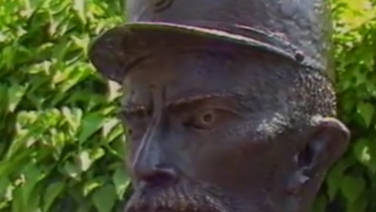

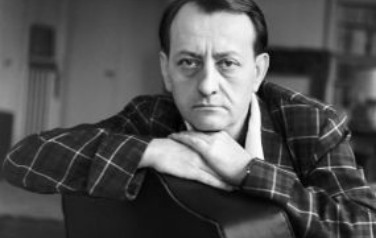 “WHAT IS THE IDEAL PALACE? IT IS THE ONLY EXAMPLE IN ARCHITECTURE OF NAIVE ART. NAIVE ART IS A BANAL PHENOMENON, KNOWN TO ALL, BUT WHICH HAS NO ARCHITECTURE… AT A TIME WHEN NAIVE ART HAS BECOME A CONSIDERABLE REALITY, IT WOULD BE CHILDISH NOT TO CLASSIFY, WHEN IT IS WE FRENCH WHO ARE LUCKY ENOUGH TO POSSESS IT, THE ONLY NAIVE ARCHITECTURE IN THE WORLD, AND WAIT FOR IT TO BE DESTROYED.”
“WHAT IS THE IDEAL PALACE? IT IS THE ONLY EXAMPLE IN ARCHITECTURE OF NAIVE ART. NAIVE ART IS A BANAL PHENOMENON, KNOWN TO ALL, BUT WHICH HAS NO ARCHITECTURE… AT A TIME WHEN NAIVE ART HAS BECOME A CONSIDERABLE REALITY, IT WOULD BE CHILDISH NOT TO CLASSIFY, WHEN IT IS WE FRENCH WHO ARE LUCKY ENOUGH TO POSSESS IT, THE ONLY NAIVE ARCHITECTURE IN THE WORLD, AND WAIT FOR IT TO BE DESTROYED.”